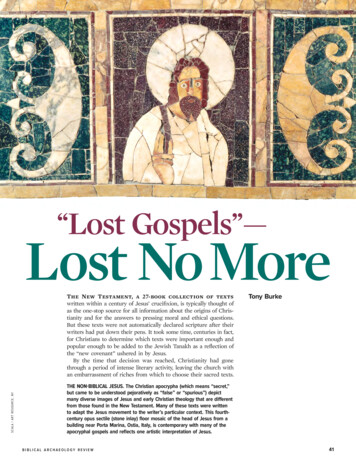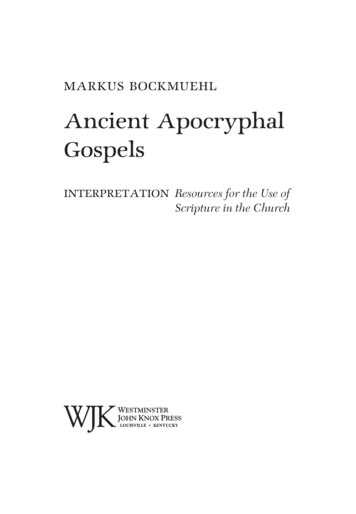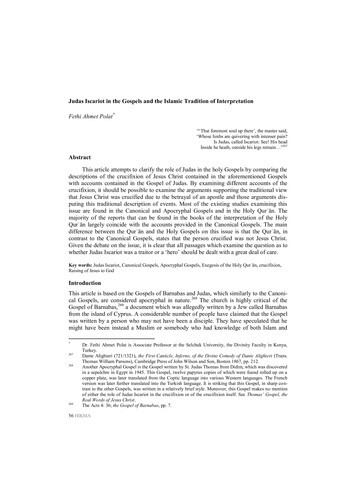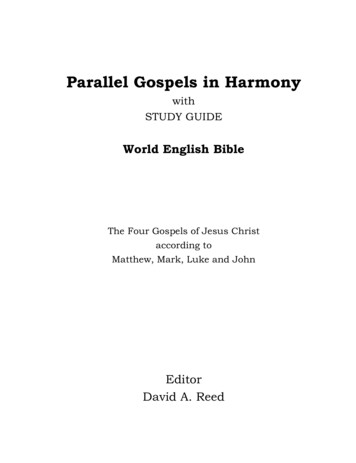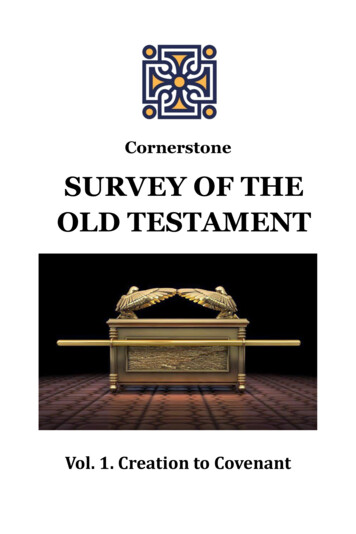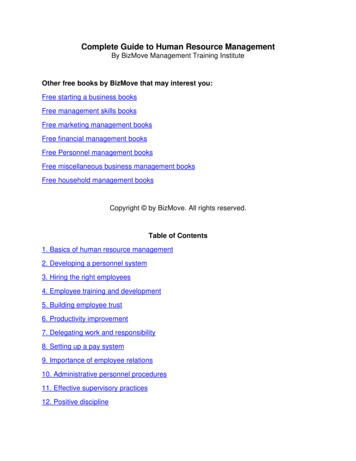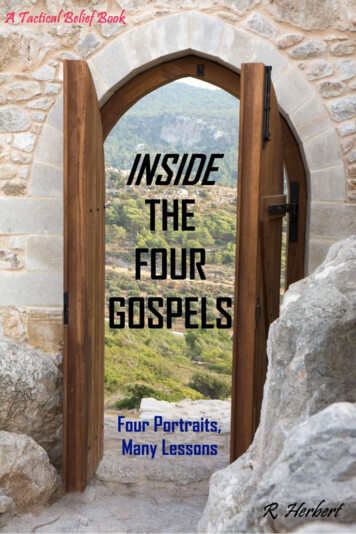
Transcription
INSIDETHE FOURGOSPELS:Four Portraits, Many LessonsBy R. Herbert
2017, Tactical Belief Books – an Imprint ofTacticalChristianity.org & LivingWithFaith.orgThe text and images in this e-book are copyright.All Rights Reserved.ISBN 978-1-64136-607-6This book is not to be sold. It is made available by the publisherwithout charge and free copies can be downloaded from:TacticalChristianity.org or LivingWithFaith.org.Unless otherwise indicated, all Scripture quotations are fromTHE HOLY BIBLE, NEW INTERNATIONAL VERSION NIV Copyright 1973, 1978, 1984 by International Bible Society Used by permission. All rights reserved worldwide.In a few cases, the ESV (English Standard Version ), HCSB(Holman Christian Standard Bible ) and NKJV (New King JamesVersion ) are cited, and these translations are also gratefullyacknowledged.About the Author: The author served as an ordained ministerand church pastor for a number of years and holds an earned Ph.D.degree in the languages, cultures and archaeology of the ancientNear East and biblical world. He writes for a number of Christianpublications and for the websites www.LivingWithFaith.org andwww.TacticalChristianity.org. His other e-books are available forfree download from those websites.Cover: Base image: by Alexei Popkov
CONTENTSIntroductionPART ONE: THE STAGE1. Judea2. Samaria3. Galilee4. DecapolisPART TWO: THE ACTORS5. The Jews6. The Romans7. The Religious Groups8. The DespisedPART THREE: MATTHEW’S STORY9. The Gospel of Matthew10. Matthew’s Portrait: The King
11. Matthew: The Gospel of Justice and MercyPART FOUR: MARK’S STORY12. The Gospel of Mark13. Mark’s Portrait: The Servant14. Mark: The Gospel of Service and HumilityPART FIVE: LUKE’S STORY15. The Gospel of Luke16. Luke’s Portrait: The Son of Man17. Luke: The Gospel of Prayer and ForgivenessPART SIX: JOHN’S STORY18. The Gospel of John19. John’s Portrait: The Son of God20. John: The Gospel of Belief and LoveAppendix: Using a Harmony of the GospelsAfterword
INTRODUCTIONWhichare the most important books of the Bible? It’s anintriguing question. They are all important, of course, but onecould make a good case that the four Gospels – Matthew, Mark,Luke, and John – are of greatest importance to the Christian.Without them the rest of the New Testament would not make anysense, and we would have no idea of the true significance of a greatdeal of what is written in the Old Testament.The four Gospels lie at the very heart of Christianity. They recordits most essential teachings and provide us with most of what weknow about the person of Jesus Christ, his fulfillments of OldTestament prophecies, his message, and his true identity. Yet manyChristians do not know why there are four Gospels, or exactly howthey differ, and what their unique lessons are.Why Four Gospels?There may have been more than four accounts of the life of Jesuswritten in the first century of the Christian Faith. Luke in his Gospelindicates that there were many such accounts. When he wrote that“Many have undertaken to draw up an account of the things thathave been fulfilled among us” (Luke 1:1), it is unlikely that he wasreferring only to the other two of our four Gospels that were inexistence by the time he was writing.But the early Christian Church preserved the four works thattoday we call the four Gospels as the accounts with the most certainauthenticity and which together showed four very different, butinterlocking views of Jesus.Although the four Gospels all tell the same story – that of the lifeand ministry of Jesus Christ – they each tell the story differently.Each of the four accounts has its own unique viewpoint and its ownperspective on the life of Jesus. This is partly because they were
written to different audiences with different concerns, but alsobecause the four accounts, similar as they may be, all have differentthings to teach us.First, each Gospel has its own unique viewpoint. This includesnot only the background and outlook of the writer, but also its wayof presenting the material and even its perspective on time.Next, each Gospel gives us a unique “portrait” of Jesus. Just asdifferent artists might paint portraits of the same individual fromdifferent angles, so the writers of the four Gospels each chose adifferent “angle,” a different aspect of the identity of Jesus to depict.Matthew depicts Jesus from a distinctly Jewish perspective, asthe Messianic King prophesied in the Hebrew Scriptures. Marklooks at him from more of a Roman perspective, showing him as aServant of the common good. Luke takes a Greek perspective,depicting Jesus in his humanness as the Son of Man. Finally, Johnportrays Jesus differently again, primarily as the Son of God. Thesedifferent perspectives of the four Gospels are well known, but wecan learn a great deal about the nature of Jesus and the work heaccomplished when we look more closely at these aspects of thefour portraits the Gospels present.Finally, all of the Gospels can be seen to have distinct themesregarding the lessons they attempt to teach. Some of these themesmay be relatively minor ones only stressed a few times in eachaccount. But each Gospel has at least two major – often related –themes that express the most important aspects of that Gospel’smessage. If we do not know what these themes are, we miss theunique message of each Gospel.Seeing the Gospels in PerspectiveBut what exactly is a “Gospel” and how should we look at theseaccounts as we attempt to understand them better? The word“Gospel” in the sense of a book about the life and teachings of JesusChrist is actually never used in the Scriptures, where the word“gospel” simply means the “good news” proclaimed by Jesus and
his disciples. The earliest known use of the word "Gospel" to denoteone of the accounts of Jesus’ life dates to the second century whenJustin Martyr (c. AD 155) wrote of the works of “.the apostles, inthe memoirs composed by them, which are called Gospels” (FirstApology, chapter 67).Most of us tend to think of the Gospels as biographies of Jesus,but they are not really biographies in the modern sense, as theyshow only certain aspects of Jesus’ identity and work while ignoringor only briefly touching on others. They are not really historicalaccounts in the modern sense, either, as they all omit large sectionsof time from his life and sometimes arrange their material topicallyrather than chronologically. So if we want to truly understand theGospels, we have to learn to see them in the context of their originalsettings – to see how and why they were individually written andwhat their authors were trying to show us.Rather than seeing the Gospels as biographies or histories, it canactually be more helpful to think of them as plays. Reading theGospels today is much more like reading the text of plays byShakespeare or some other great writer. When we simply readthose plays, we can see their plot and essential message, but if wesee the plays performed on stage we see things much more clearly –the stage settings, the costumes of the actors, and even minor butimportant details such as the expressions of the actors.Reading the four Gospels is a similar experience. If we learn andunderstand the background to the Gospels, the characters, the“stage” they acted upon, and so forth, we gain a far deeperunderstanding of what the Gospels are saying. That is why in thisbook, in order to get “inside” the four Gospels, we look first in PartOne at the overall background – the “stage” – the stories wereplayed out upon. Then in Part Two we look at the groups we meet inthe Gospel accounts – the “actors” in the stories. Finally, in PartsThree through Six, we look at the “play” – the story itself –examining each Gospel individually in terms of its particularbackground, its portrait of Jesus, and its great themes.
No matter how many times we have read the four Gospels, takingthe time to look inside them – to better understand their uniqueperspectives and individual messages – can richly repay us withinsights that increase our understanding of the person and work ofJesus Christ and the messages that the four Gospels contain abouthim. The four Gospels are certainly among the most importantbooks of the Bible. Isn’t it time you got to know them better?
PART ONE:THE STAGE
1. JUDEAAs the “curtain rises” on the four Gospels, we findthat the storybegins – in each of them – in Judea. This area was the central (wemight say “center stage”) region of Palestine in which the story ofJesus both begins and reaches its climactic ending.Judea or “Land of the Jews” is itself the ancient Roman name,found in the New Testament, for the southern part of Palestinestretching from the border of Samaria in the north to the Sinai inthe south.Originally, it was the area of Israel settled by the biblical tribes ofJudah and Benjamin; after the division of Israel following the deathof King Solomon, it became the “kingdom of Judah” as distinctfrom the “kingdom of Israel” to the north.These kingdoms remained separate states for over two hundredyears with Israel having its capital in Samaria (see chapter 2) andJudah maintaining its capital in Jerusalem. Once Palestine becamepart of the Roman Empire in the first century BC, the Romansincorporated the historical Judah and also Samaria and some otherareas into the “Province of Judea.”Although the Romans controlled Judea, they allowed traditionalmonarchs of the Herodian family to rule as puppet kings. Judahhad earlier conquered the nearby area of Idumea (Edom) andforced the Edomites to convert to Judaism. Ironically, Herod theGreat (died c. 4 BC) and his successors were of Idumean rather thanJudean descent.Geographically, most of the region of Judea was mountainous“hill country” which dropped down into plains in the west andsouth. The famous line “I will lift up my eyes to the hills” in theBook of Psalms refers specifically to the act of going up into the hillcountry to the temple of God in Jerusalem.Jerusalem itself not only stood on four hills or mountains, butwas also surrounded by others such as the Mount of Olives that weread about in the Gospels. These same mountains are frequently
mentioned in the teachings of Jesus, who retreated to them onmany occasions to pray privately or to get away from the crowds,who spoke of faith that could “move mountains,” and who mademany other references to them.The “wilderness of Judea,” located in the eastern part of Judeanext to the Dead Sea, was a particularly desolate part of this areawhere John the Baptist began to preach and where Jesus wastempted. Compared to this desert “wilderness,” the rest of Judeawas relatively productive and supported the growing of variouscrops such as olives and the pasturing of smaller animals such assheep and goats.A number of Judean cities and towns such as Bethlehem,Bethany, Jericho and Emmaus appear in the Gospel stories, butnone was so important, of course, as the capital, Jerusalem, whichhad a population of many thousands in New Testament times.Jerusalem is mentioned by name 146 times in the New Testament,and many other references to the city occur in the Gospels undersynonyms such as “Zion” (named after one of Jerusalem’s fortifiedhills), “the holy city” (Matthew 4:5) and “the city of the Great King”(Matthew 5:35).Because it was the location of the temple, for the Jews Jerusalemfunctioned as the spiritual center of Judea, although the religiousauthorities there were often at odds with the messengers of God. AsJesus himself said, " Surely no prophet can die outsideJerusalem!" (Luke 13:33). There was also frequent religious frictionbetween the inhabitants of the areas of Galilee and Judea.So despite the regional importance of Judea, it is understandablethat relatively little of the life of Jesus was spent in this area, and hewas often in danger when he did spend time there. It is vital tounderstand this fact as two of the Gospel writers, Matthew andMark, actually structure their story around this tension whichculminated in the death of the prophet from Galilee at the hands ofthe religious leaders of Judea.Despite his rejection by the Judean authorities, Jesus stillmourned over the impending destruction of Jerusalem (Matthew
23:37-39, Luke 19:41-44), and his prediction that the city’s enemies“ will not leave one stone on another, because you did notrecognize the time of God’s coming to you” (Luke 19:44) wasdrastically fulfilled by the Romans within a generation.But Jerusalem and several other Judean locations were of greatprophetic significance, and the Gospels show that Jesus spent timein them in order to fulfill the prophecies made in the HebrewScriptures regarding the promised Messiah. The centrality ofJerusalem for the Gospels is also seen in the command of theresurrected Jesus that his disciples preach in his name to all nations“beginning at Jerusalem” (Luke 24:47).
2. SAMARIASamaria was the area between Judea and Galilee that had been thenorthern kingdom of Israel after Judah and Israel split into twomonarchies following the death of Solomon around 931 BC. Sometwo hundred years later, in 726–722 BC, the Assyrian kingShalmaneser V invaded the region, captured the capital city ofSamaria (after which the region was named), and deported many ofits inhabitants to Assyrian cities in Mesopotamia. But some of theSamaritans remained in their land and eventually mixed with othergroups who moved into the area.This mixed – partly Jewish and partly pagan – populationrepresented the Samaritans of Jesus’ day. Although they worshipedthe same God as the Jews and strictly upheld the commands of theMosaic law, their religion was rejected by Judaism – both becauseof their partly Gentile ancestry and because the Samaritansaccepted only the first five books of the Bible and worshiped in theirtemple on Mount Gerazim in Samaria rather than in the temple inJerusalem.As a result, the Samaritans were despised by most Jews – whotreated their northerly neighbors terribly, as virtual “untouchables.”The depths of this terrible disdain can be seen in the fact thatSamaritans could not even be accepted as converts to Judaism.Rather than “contaminate” themselves by passing throughSamaritan territory, Jews who travelled between Judea and Galileewould often cross over the River Jordan in order to bypass Samaria,rather than going through the area. Those who did take the directroute would hurry so as not to stay overnight there and would evenrefuse to eat in that area.This attitude is reflected in later statements in the JewishTalmud such as: “He that eats the bread of the Samaritans is like toone that eats the flesh of swine” (Mishnah Shebiith 8:10). Perhapsunderstandably, the Samaritans developed a deep antipathy towardthe Jews, and there is no question that there was a great deal of
mutual hostility and religious rejection between the two cultures(Luke 9:52-53).This was the situation in the society into which Jesus was born.When we understand this background, we see how remarkableJesus’ teaching and actions regarding the Samaritans truly were.We can sense the shock among many of his Jewish listeners whenChrist told the parable of the “Good Samaritan,” an individual heheld up as being not only “our neighbor,” but also someone morerighteous than a representative priest and Levite – the Jewishreligious professionals of that day (Luke 10:25–37).The nature of Jewish-Samaritan relations (or lack of them) helpsus to realize what a statement it was that Jesus chose to passdirectly through Samaria instead of crossing the Jordan to avoid thearea on the way to Jerusalem (John 4:4-5) as many Jews did.When Jesus spoke with a Samaritan woman outside one of theircities, it was directly contrary to Jewish custom (John 4:9), andwhen he agreed to eat with the Samaritans of the area – and evenstay with them overnight – it was the ultimate outrage from theperspective of the Jews: Jesus accepted the Samaritans as being nodifferent from the Jews themselves.When Jesus healed ten lepers from the border of Samaria (Luke17:11-14) – at least one of whom was a Samaritan (vs. 16) – heshowed again that he loved the Samaritans as much as he didanyone else. In his teaching and serving alike, Jesus accepted andcared for the Samaritans in a manner that completely negated their“untouchable” status in the eyes of many Jews.So, despite widespread Jewish antipathy, it is not surprising thatthe early Church quickly recognized the believers in Samaria asequal to the Jews. Many Christians spread through the area ofSamaria (Acts 8:1), and the evangelist Philip taught there (Acts 8:58). Significantly, the leading apostles Peter and John were sent ona special mission to the area to confirm those Samaritans who hadbeen baptized by Philip (Acts 8:14-17) and to show that theiracceptance was the official position of the Church.
The ready acceptance of Christianity by many Samaritans islikely due to their expectation of a Taheb or “Restorer,” a Messiahlike figure whom they understood would be the prophet like Mosesforetold in the Scriptures (Deuteronomy 18:15, 18). The Taheb,they thought, would be so much like God that anyone who believedin him would believe in the Taheb’s Lord (God himself).In his ministry, Jesus had taught that the time was coming whenworship in the holy places of both Jerusalem and Samaria would nolonger be important (John 4:21), and the conversion of manySamaritans was one of the first steps in the realization of that truth.The embracing of Christianity by many Samaritans became a clearintermediate step between the preaching of the Gospel to the Jewsand to the Gentiles – just as Christ had predicted (Acts 1:8).A few ethnic Samaritans still survive in their homeland today –mainly in the city of Nablus in what is now northern Israel – andhave maintained their traditional identity and worship. SomeSamaritan Christians also maintain their faith – descendants of thesecond oldest Christian community in the world, and the only groupof believers founded outside of Judea by Jesus himself.
3. GALILEEThroughout the life of Jesus, all of Palestine was divided into threeRoman provinces, Judea, Samaria, and Galilee, with Galilee beingthe largest (Luke 17:11). The region of ancient (and modern) Israelthat we call Galilee apparently was originally just a small circle ofland (the name Galilee means “circuit” or “circle” in Hebrew)around the Canaanite city of Kedesh, which was conquered byJoshua and became part of the inheritance of the tribe of Naphtali(Joshua 20:7).But the region quickly grew and it was in this area that thetwenty towns were located that King Solomon gave to Hiram, Kingof Tyre, in payment for the workmen and cedar wood supplied fromLebanon for building the temple in Jerusalem (1 Kings 9:11).Perhaps it was then that the area became settled by Gentiles fromPhoenicia, though this may have occurred at a later time when theAssyrians moved other populations into the area after the captivityof ancient Israel.Geographically, the area of Galilee is extremely hilly and rocky,and most people lived in small villages – though the cities such asTiberias built on the shores of the Sea of Galilee were larger. TheSea of Galilee was, in fact, the central focal point of the wholeregion. Also called in the Bible the Sea of Kinneret (possibly fromthe “harp” shape of the lake) or its Greek form, Gennesaret, as wellas Ginosar and the Sea of Tiberius, the large lake (todayapproximately 7 miles wide and 12.5 miles long) was the center ofthe fishing trade which was Galilee’s main industry.Many Bible commentaries give a picture of ancient Galilee as arustic and socially backwards area looked down upon by Jews inJerusalem and elsewhere. However, modern archaeology has shownthat although the Galileans may have had a different accent(Matthew 26:73) and not have had the education of many of theJerusalem elites (Acts 4:13), they were nevertheless respected fortheir thriving commerce.
Galilee was much more fertile than Judea and Samaria and thearea was also known for its natural beauty. The Jewish historianJosephus who lived shortly after the time of Christ (c. AD 37 –100)even wrote that “One may call this place the ambition of Nature.”The Synoptic Gospels (Matthew, Mark, and Luke) all givedetailed accounts of the ministry of Jesus which was conducted inGalilee. They tell us that it was there that Jesus chose his disciplesand where he taught and performed many miracles in the scatteredvillages and towns. Matthew tells us that he did this: to fulfill what was said through the prophet Isaiah: “Land ofZebulun and land of Naphtali, the Way of the Sea, beyond theJordan, Galilee of the Gentiles — the people living in darknesshave seen a great light; on those living in the land of theshadow of death a light has dawned” (Matthew 4:14-16,quoting Isaiah 9:1-2).Yet why did Jesus spend so much of his earthly life in Galilee? Itwould have been possible, of course, for him to have grown upanywhere in Judea and to have simply travelled to Galilee tocomplete his prophesied work there. Most scholars feel thatbecause Galilee was relatively distant from the political andreligiously volatile situation in Jerusalem, Jesus’ ministry was morelikely to thrive and survive in that more out of the way area.But there is perhaps another reason why so much of Jesus’ministry was completed in Galilee – and that was the nature of theGalileans themselves. The common stereotype that paints theGalileans as unsophisticated and “backwoodsy” fails to take intoaccount an important trait for which they were well known. Thehistorian Josephus also wrote of the Galileans that they were “fondof innovations and by nature disposed to change, and they delightedin seditions.”The latter charge, that they were fond of political seditions, wasseen in the revolt against the Romans led by Judas of Galilee in AD6 and mentioned in the New Testament (Acts 5:37).
However, the fact that the Galileans were socially andtemperamentally inclined to innovation and change meant that theywere doubtless far more receptive to the seemingly radical newteachings of Jesus. Far less constrained in what they believed thanthe tradition-bound Jews of Jerusalem, the Galileans (apart fromJesus’ own family and those who had known him as a child Matthew 13:54-58) may have been more open to the message of theGospel than any other group in ancient Palestine. It was among theGalileans, as Isaiah prophesied, that the light that was to comeshone most brightly.
4. DECAPOLISTheDecapolis was the Gentile-controlled area mainly on theeastern side of the River Jordan and the Sea of Galilee in what isnow part of modern-day Israel, Syria, and Jordan. The area is onlymentioned by this name three times in the New Testament(Matthew 4:25, Mark 5:20, 7:31), but it was the location of someimportant events recorded by the Gospels.In the time of Jesus, the Decapolis – meaning “ten cities” – was aloosely connected group of towns and cities given some degree ofautonomy by the Romans, who encouraged the development oftheir own culture in the region. Each city functioned as a separateentity with its surrounding countryside – so the area around thecity of Gadara, for example, was called the region of the“Gadarenes.” Ancient texts list between 9 and 18 cities in theDecapolis, showing that the “Ten Cities” was more a general termfor the region than a factual number of the towns in it.The inhabitants of the Decapolis were almost exclusively Gentilesand were disliked and avoided by many Jews owing to their paganbackground and culture (Mark 5:11, etc.). Both the Jewish Talmudand some of the early Christian writers indicate it was believed thatthe people of the Decapolis were the descendants of the sevenCanaanite “nations” which were driven out of the Promised Land byJoshua (Joshua 3:10, Acts 13:19).Additionally, the New Testament shows that, contrary to Jewishlaw and custom, the people of the Decapolis kept pigs (Mark 5:11)which they doubtless ate and sacrificed in their temples. So,because of their culture as well as their real or imagined history,these people were rejected outright by the Jews.But the Gospels show that despite this background, Jesus went tothese people and showed them acceptance by preaching the Gospelto them as well as healing their sick. The story of his casting out ademon from one of the Gadarenes figures prominently in theGospel of Mark. Interestingly, although Matthew 15:24 tells us that
Jesus stressed while he was in the Gentile area of Tyre and Sidon onthe Palestinian coast that he was not sent to the Gentiles, while hewas in the Decapolis Jesus freely healed and encouraged those hehelped to spread the word of the healings (Mark 5:19-20).This also helps us to better understand the stories presented inthe New Testament Gospels of the miracles of the feeding of the fivethousand and of the four thousand. Many people read these storieswithout noticing or thinking about the fact that one of the miracleswas performed on the Jewish, western side of the Sea of Galilee(Matthew 14:13-21), while the other was performed on the pagan,eastern side – in the Decapolis (Matthew 15:29-39).When we read these stories, we see that Jesus commanded hisdisciples to pick up the leftover food. After the feeding of the fivethousand in Galilee, there were twelve baskets of food left over –clearly symbolic of the twelve tribes of Israel and Christ’s role inproviding spiritual “food” for all Israel. After the parallel miracleperformed on the east side of Galilee in the Decapolis, we are toldthe disciples picked up seven baskets of leftover food – doubtlesssymbolic of the Gentile people of the “seven nations” of Canaanitesbelieved to dwell there.When we see this, we realize what a powerful message thesemiracles were to the people who witnessed them – not only thecompassionate feeding of thousands of people, but also the deepermessage of Christ’s compassion for and desire to include thedespised Gentiles in his teaching and providing of spiritual food.Perhaps not surprisingly, the Gospel of Matthew tells us that manypeople from the Decapolis followed Jesus (Matthew 4:23-25).For us today, the New Testament stories of the Decapolis providean excellent reminder of how we can often better understand themessage of the Gospels when we better understand the “stage” onwhich the stories were set.
PART TWO:THE ACTORS
5. THE JEWSAt the time of Jesus, the northern ten of the Twelve Tribes of Israelhad long since been carried into Assyrian captivity andsubsequently scattered. The people of Judea were mainly thedescendants of the southern tribes of Judah and Benjamin – theJews – who had returned from their own captivity in Babylon.As a result, all people of Israelite ancestry throughout the Romanworld came to be known as “Jews.” On the other hand, the terms“Israel” and “Israelites” were often still used by the Jewsthemselves, just as we find that Jesus calls Nicodemus “Israel’steacher” in John 3:10 and calls Nathaniel an “Israelite” in John1:47. The two terms could thus be interchangeable in NewTestament times. That is why John calls Jesus the “King of Israel”(John 1:49, 12:13), and also records the fact that he was crucified as“King of the Jews” (John 19:19-22).But when the term “Jews” is used in the Gospels, it can havedifferent meanings. When Jesus speaks of “the Jews” he sometimesmeans the inhabitants of Jerusalem and Judea as opposed to thepeople of Galilee, and he also often means just the religious leadersof that culture.Although the religious leaders of the time personified theirJewish culture in many ways, they also fell far short of theprinciples of the Hebrew Bible that they ostensibly taught andupheld. Both John the Baptist and Jesus himself chastised theJewish religious leaders for their hypocrisy and lack of true religion,but the Gospels make it clear that many everyday people of Judeawere sincere and devout. The stories of John the Baptist’s fatherand mother, Zechariah and Elizabeth (Luke 1:5-80), are goodexamples, as are those of Jesus’ own human parents, Mary andJoseph (Luke 2:1-21).Also, many of the Jews who heard the teaching of Jesus werereceptive to it and became the first Christians. In fact, Christianity
in its formative stage was considered to be a sect of Judaism, andwe should realize that a great deal of what the four Gospels tell uscan only be properly understood in the light of the first centuryJews and their culture. Throughout the Gospels, for example, thelife of Jesus is shown as the fulfillment of the promises given in theHebrew Scriptures to the Jewish people by the prophets, and beforethem to their ancestors David (Psalm 89:3–4, 29–36; 132:11–17,etc.), Moses (Deuteronomy 18:15), Abraham (Galatians 3:16), andeven Eve (Genesis 3:15).If we want to see more deeply inside the Gospels, we must neverlose sight of the fact that Jesus was himself a Jew who practicedJewish religion and preached primarily to Jewish people usingstories and analogies that the Jews of that era would understand.Historically, Jesus is the first individual known by name who wascalled “rabbi,” meaning “teacher.” As we progress in this book, wewill see that the Gospels do not simply record the major events ofChrist’s life, but dwell mostly on his teachings.When we read these teachings, we must see them as the Jewssaw them to fully understand them. To take a single example,Jesus’ parable of the “Prodigal Son” is viewed by most Christians asthe father in the story representing God and each sinful human asthe son whom the father forgives. While this may be the centralmeaning of the parable, we must not forget that to the Jewishaudiences who heard this story, one of its most noticeable aspects isthat the man had two sons – one good and one not good. Thiswould have immediately reminded Jewish listeners of biblicalstories such as those of Cain and Abel, Ishmael and Isaac, Esau andJacob, and Jose
Matthew: The Gospel of Justice and Mercy PART FOUR: MARK’S STORY 12. The Gospel of Mark 13. Mark’s Portrait: The Servant 14. Mark: The Gospel of Service and Humility PART FIVE: LUKE’S STORY 15. The Gospel of Luke 16. Luke’s Portrait: The Son of Man 17. Luke: The Gospel of Prayer and Forgiveness PART
